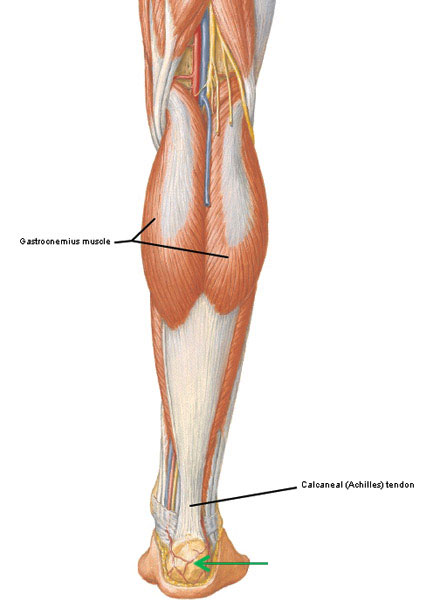Are you suffering from pain in your Achilles? This could be because you engage in physical activities like sports or physical labor in your line of work that requires repetitive motion in the ankle. Repetitive motions could be endurance activities like running or biking in which you are overusing the Achilles tendon, jumping in Volleyball or Basketball, and even occupations that require constant standing; ladies, too much time in 2.5 inch or more heeled shoes can be a culprit as well.
Understanding the Achilles
Your Achilles tendon is found in the calf area (lower leg) made up of two muscles called the soleus and the gastrocnemius. It attaches all the way into the heel bone at the part called the calcaneal tubercle. This area has two major bursa (fluid) sacs called the subcutaneous calcaneal bursa and the retrocalcaneal bursa that fill with fluid when they become inflamed. When you injure this area, the sacs fill with fluid and become an issue, especially if it’s the retrocalcaneal bursa that is affected.
What happens during an injury?
When you do a repetitive action, like running, in the region of the ankle, your Achilles tendon begins to rub against the bone, and can cause actually calcification in part of the tendon, effectively creating a new bone in the area. The new bone can then push the bursa in the area which causes some irritation and swelling while it fills with fluid.
This new bone being created is often called the “pump bump” and can actually start to calcify even if the bursa begins to heal. This means you’ll potentially need surgery to remove the new bone unless you’re able to get other types of therapy to correct the issue.
Additionally, you may end up with pain from the muscle tightening of the Achilles tendon. The pain is actually caused from abnormal loading because there is additional stress being placed on this area from the muscles being too tight.
Treating and avoiding Achilles Tendonitis
Going forward, you’ll want to work on steps to treat your Achilles issues and prevent them going forward. This means that you need to be wearing appropriate shoes during activities like walking and running, as well as correcting health issues like being overweight, diabetes, and gout.
Once the Achilles tendon is injured, it takes a long time to heal, making prevention the most important tool at your disposal. ***General guidelines: For irritation to the area, make sure you refrain from exercise for a few weeks while you rest and apply 20 minutes of ice at a time.***
If you’ve started to feel a minor twinge or stiffness in the tendon connecting your heel and calf, it’s time to get help right away. The pain may dissipate as the tendon stretches but that does not mean it’s healed. It could eventually lead to burning or shooting pain, or the tendon may tear. I’ve seen a few cases and believe me, this is NOT fun.
If you have flat feet, wear high heels, or forget to stretch before exercise, you could be at risk for this condition. Be sure to start warming up before exercise, wear proper support and let a chiropractor check to see if your pelvis is aligned properly.



